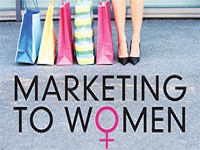Insights for Marketing to Women

Marketing to Women: Helpful Insights
By now we all know that women are the primary consumers in the U.S. today, making over 85 percent of the consumer purchase decisions and influencing over 95 percent of total goods and services purchased. Women’s consumer and business spending is fast approaching $8 trillion – more than the economy of Japan. When marketing to women, businesses need to keep the following in mind:
There is no “women’s market” — there’s your women’s market.
Marketers should not segment women strictly by age. Whether a woman is 28, 39, or 52, she’ll respond more to marketing messages that address her life stage, not her biological age. Unlike previous generations, today’s women are experiencing life in a less linear fashion; women are having babies in their 40s, starting new careers in their 50s, and re-entering the dating scene in their 60s. Marketers need to clearly understand the differentiation in marketing to the different life stages of women, and tailor their messages accordingly.
Pink is not a marketing strategy.
Today’s women are not looking for a watered-down version of a male offering that has been feminized with clichéd colors. Instead, they’re looking for solid information, ease of use, stellar customer service, and brands that are looking to build real relationships with them based on their interests, personal identities and problems that they need to solve.
Instead of relying on outdated assumptions and stereotypes, marketers must do the hard work to be relevant to women consumers – taking the time to learn what motivates them to order to present their brands in a meaningful way. A woman’s b.s. meter is always on – she knows when she’s being addressed in an authentic way…and when she’s not.
Recognize that women think different than men.
All human brains start as female brains, until the male brain is flooded with testosterone. But there they part paths. A woman’s brain has four times as many connections between the left and right hemispheres as a man’s. All of those signals hurtle down the superhighway into her right brain – the home of emotional memory, intuition and experience. A woman not only reads – she attaches feelings to what she’s reading. A woman’s heart is in her brain – tell her a story that is filled with emotion, and explain why your brand is relevant to her.
Sounds simple, but many businesses develop and market products without ever asking their female customers what is most important to them and why. Companies such as Best Buy and Volvo have made gaining women’s input a key part of their marketing process, leading to product improvements that both men and women appreciate, along with marketing messages that resonate with both.
Don’t buy into a woman’s “Half Truth.”
A Half Truth is what a woman is willing to admit, while the Whole Truth is what she really believes, does and buys. For example:
“I am happy with my looks.” (Half Truth)
“If given a choice, I’d like to look better than I do.” (Whole Truth)
A woman’s half-truth can cost marketers billions of wasted dollars not just in concept development and market research, but in the marketplace where it really hurts. Marketers need to take the time to really understand the women they’re talking to – what motivates them and what makes them tick.

Understanding How She Thinks | Girltalk
January 10, 2012 @ 8:50 am
[…] The differences between women and men are not only well-documented, but frequently at the heart of jokes and good-natured ribbing. The fact is, men and women simply are wired differently. […]
Marketing to Women by Storytelling | Girlpower Marketing
March 17, 2017 @ 2:37 pm
[…] who has been reading this blog knows that women think differently than men. We’ve talked about how a woman’s brain has four times as many connections between the left […]
Marketing to the Female Brain | Understanding How She Thinks
May 9, 2017 @ 5:54 pm
[…] The differences between women and men are not only well-documented, but frequently at the heart of jokes and good-natured ribbing. The fact is, men and women simply are wired differently. […]